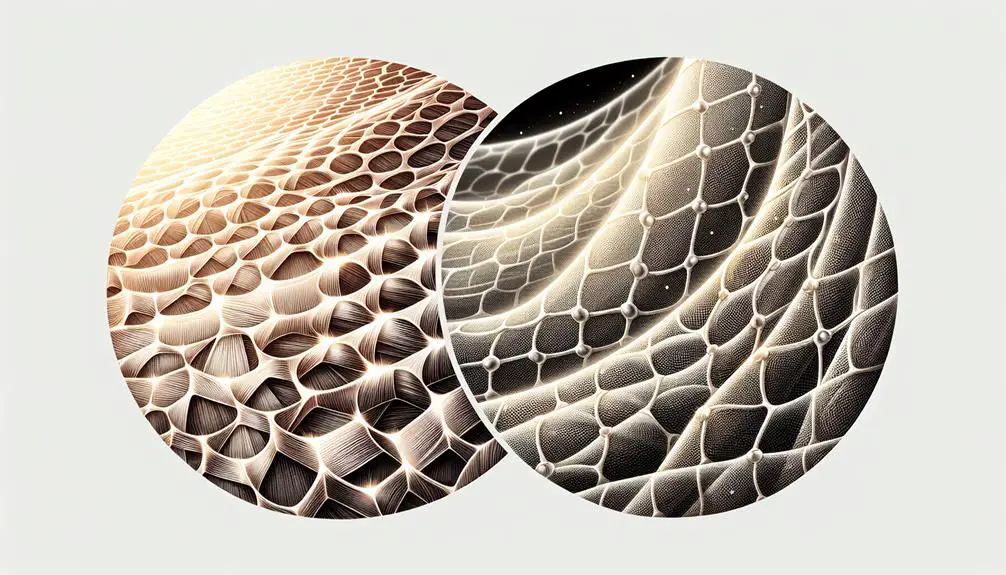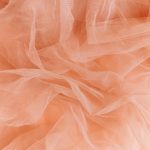As someone who enjoys working with different fabrics, you might not be aware of the subtle yet significant differences between organza and tulle. These two materials, often confused due to their sheer appearance, have distinct characteristics that can greatly impact the outcome of your projects.
Understanding how organza's stiffness contrasts with tulle's drapability can elevate your creations in ways you might not have considered.
Table of Contents
Key Takeaways
- Organza is sheer with a crisp texture, while tulle is light and airy.
- Organza adds structure, tulle drapes well for volume.
- Organza is stiffer, tulle is delicate and versatile.
- Organza suits overlays, tulle is ideal for bridal veils and decorations.
Key Characteristics of Organza
Organza, known for its sheer and smooth appearance, is a fabric that adds structure and elegance to garments such as wedding gowns and evening wear. Unlike tulle, organza is a stiffer fabric that doesn't have the same level of stretch. This lack of elasticity gives organza its characteristic ability to hold shapes and create more structured silhouettes in clothing.
When comparing organza to tulle, one can immediately notice that organza has a more pronounced sheen and crisp texture, making it ideal for garments that require a more formal or structured look. The sheer fabric of organza allows for a delicate yet elegant touch to any outfit, making it a popular choice for overlays, veils, and linings.
However, it's important to note that organza is more prone to wrinkling and snagging due to its delicate nature, requiring careful handling during garment construction.
Properties of Tulle Fabric
When it comes to the properties of tulle fabric, its texture is light and airy, giving off a whimsical feel.
The color options in tulle are vast, allowing for creativity in designs.
Tulle fabric is versatile, finding its place in bridal gowns, veils, and even decorations.
Tulle Fabric Texture
With its sheer and open-weave texture, tulle fabric creates a light and airy feel that's ideal for adding dimension to designs. When comparing tulle to organza, tulle's texture is slightly stiffer but still maintains a soft and delicate quality, making it versatile for various projects.
Here are three key points about the texture of tulle fabric:
- Drapes and Holds Volume: The unique texture of tulle allows it to drape elegantly while also holding volume well, perfect for creating dramatic silhouettes.
- Soft and Delicate: Despite its slight stiffness compared to chiffon, tulle remains soft and delicate to the touch, enhancing its appeal in various applications.
- Versatile Use: Tulle's texture makes it a popular choice for bridal veils, skirts, and overlays, showcasing its adaptability in different fashion pieces.
Tulle Fabric Colors
Tulle fabric offers a vibrant array of colors, ranging from traditional hues to bold and shimmering options, enhancing its versatility in various design projects. Tulle fabrics are available in an extensive range of colors to suit different preferences and design needs. Here are some popular tulle fabric color options:
| Traditional Colors | Pastel Shades | Vibrant Colors | Metallic Options |
|---|---|---|---|
| White | Blush Pink | Red | Gold |
| Ivory | Champagne | Royal Blue | Silver |
| Black | Mint Green | Emerald Green | Copper |
Additionally, ombre tulle fabrics provide a unique gradient color effect, transitioning smoothly between hues for a distinctive look.
Tulle Fabric Uses
Known for its airy and delicate nature, tulle fabric is a favorite choice for adding elegance and charm to various fashion pieces. When it comes to fabric uses, tulle stands out for its versatility and beauty. Here are some common applications of tulle:
- Bridal: Tulle is often used in bridal accessories and wedding gowns due to its romantic and ethereal appearance.
- Sheer fabrics: Tulle is perfect for creating sheer overlays on garments, adding a touch of sophistication and grace.
- Volume and movement: This fabric is ideal for adding volume and movement to garments like tutus and formal gowns, making them look ethereal and graceful.
Comparison of Sheerness
When comparing organza and tulle, the sheerness of the fabrics plays a significant role in their overall appearance. Organza's translucency allows light to pass through subtly, while tulle's sheer quality creates a more see-through effect with tiny holes.
Understanding the sheer factor and transparency levels of these fabrics can help in choosing the right material for different design purposes.
Sheer Factor
With its more translucent nature allowing increased light penetration, organza surpasses tulle in sheer factor, emphasizing a smoother and shinier appearance.
When comparing the sheer factor between organza and tulle, here are the key differences:
- Organza is more translucent than tulle, enhancing its light-reflecting properties.
- Tulle, with its more open weave, creates a sheerer effect, offering a delicate and airy look.
- Organza's smoother and shinier appearance sets it apart from tulle, giving it a more luxurious and refined aesthetic.
Understanding these distinctions can help in choosing the right fabric based on the desired level of sheerness and overall look and feel of the garment.
Transparency Levels
In terms of transparency levels, organza and tulle differ significantly in their sheerness, impacting the overall appearance of garments and accessories.
Organza, being more translucent than tulle, allows a higher amount of light to pass through, giving it a delicate and elegant look. On the other hand, tulle's more open weave creates a semi-transparent finish, known for its sheer quality that imparts an ethereal charm to designs.
While both fabrics possess a sheer quality, organza may appear denser and less see-through compared to the light and airy nature of tulle.
The varying transparency levels of organza and tulle play a crucial role in determining the final aesthetic and texture of the finished product, making them distinct choices for different design needs.
Weight and Texture Variations
Organza and tulle exhibit distinct weight and texture variations that contribute to their unique aesthetic appeal.
- Stiff vs. Lightweight Fabric:
- Organza is commonly known for its stiff texture, providing a structured and crisp feel.
- Tulle, on the other hand, is typically lighter and more delicate, offering a floaty and ethereal touch.
- Fine Weave Differences:
- The weave of organza can range from ultra-thin to almost as thick as canvas, allowing for various draping effects.
- Tulle's texture can vary from smooth to slightly scratchy, depending on the specific type of tulle fabric used.
- Common Usage and Textural Feel:
- Organza is commonly used in elegant, formal attire due to its structured nature.
- Tulle, with its delicate and ethereal quality, is often seen in wedding veils and ballerina tutus, adding a soft and dreamy feel to garments.
Sewing Challenges and Tips
Navigating the delicate nature of sewing with tulle presents both challenges and opportunities for creating ethereal and whimsical garments. When working with tulle, it is crucial to use a sharp needle on your sewing machine to avoid snags and ensure precise stitches. Due to tulle's delicate nature, it's advisable to practice on scraps before moving on to your final project to familiarize yourself with its unique properties. To prevent tulle from slipping during sewing, consider using tissue paper underneath or attaching a walking foot to your sewing machine for more control. Ironing tulle directly can damage the fabric, so opt for a pressing cloth on low heat to remove wrinkles gently. When hemming tulle, a rolled hem or a narrow zigzag stitch works best to maintain its light and airy quality.
| Sewing Challenges | Sewing Tips |
|---|---|
| Delicate nature of tulle | Use a sharp needle for clean stitches |
| Slippery fabric | Use tissue paper or a walking foot attachment |
| Avoiding fabric damage | Iron with a pressing cloth on low heat |
| Hemming considerations | Opt for a rolled hem or narrow zigzag stitch |
| Practice makes perfect | Test on scraps before working on final garment |
Ideal Applications and Projects
When working with tulle in sewing projects, it's essential to consider the specific applications and projects where this delicate fabric shines. Tulle is a versatile material that can elevate various creations.
Here are some ideal applications and projects for tulle:
- Choice for Bridal: Tulle is a popular choice for bridal attire, including veils and gowns. Its ethereal and romantic appearance makes it a top pick for brides looking for a dreamy aesthetic.
- Used as an Overlay: Tulle is often used as an overlay in garments to add texture, volume, and a touch of whimsy. It can transform a simple dress into a stunning piece fit for special occasions.
- Great Choice for Formal Wear: Tulle is a great choice for formal wear such as evening gowns and cocktail dresses. Its lightweight nature allows for creating voluminous designs without adding bulk, making it perfect for elegant and graceful looks.
Frequently Asked Questions
What Is Difference Between Organza and Tulle?
Choosing fabrics is akin to selecting brushes for a masterpiece. Organza structures like a firm stroke, while tulle dances with grace, a delicate hue. Each tells a story; one bold, the other whimsical. Design speaks volumes.
Which Is Better Tulle or Chiffon?
When deciding between tulle and chiffon, I prefer tulle for its ability to add volume and a romantic touch to designs. Chiffon, on the other hand, offers flowing elegance and luxurious draping, making it ideal for warm weather events.
What Is the Difference Between Organza and Chiffon Fabric?
Organza and chiffon both offer unique qualities. Organza provides structure and is prone to wrinkling, while chiffon is soft and flows gracefully. Understanding these differences helps in selecting the right fabric for specific design needs.
What Fabric Is Like Tulle but Softer?
Oh, you want something softer than tulle? Enter chiffon! It's like wrapping yourself in a cloud. Lightweight, flowing, and oh-so-elegant. Perfect for those dreamy, romantic looks that make you feel like royalty.
- Does Chiffon Fabric Stink - July 15, 2025
- Does Chiffon Fabric Affect the Economy - July 15, 2025
- Does Cotton Fabric Have a Nap - July 15, 2025




